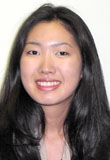What's New?
The 2001-2002 Beckman Scholars: Stella Kijung Kang (Maeng), MD
Beckman research project in the Belcher group: RNA-Directed Design of Nanostructures using Peptides with Nanocrystal Binding Specificity |
The use of biological systems to design the next generation of microelectronic devices offers a possible solution to the problems posed by traditional materials processing methods. While lithographic technology is reaching its limitations, biological systems which routinely form organic-inorganic structures (e.g. bones) by a variety of processes provide a way to selective, self-organizing design of nanoscale building blocks. In order to harness the biological recognition of inorganic substances occurring in nature, Dr. Belcher employs peptides evolved to bind specifically to a certain inorganic substrates. The study of such biological-inorganic specificity of peptides to specific inorganic substrates lays the groundwork for directing the self-assembly of electronic materials. Furthermore, RNA templates can be used to dictate the assembly of nanostructures through polypeptide synthesis. The binding specificity of peptides to inorganic substrates were established through selection of phage displaying the peptides. The Belcher group uses a peptide combinatorial approach to identify proteins that select for and specifically bind to inorganic nanoparticles such as semiconductor quantum dots or nanoparticles of iron and tin oxides. Phage display libraries are used to select peptide sequences that will bind to the materials. This phage library is based on a combinatorial library of random peptides of a given length (e.g. 7-mer or 12-mer) that are fused to the pIII minor coat protein of the filamentous coliphage M13. Five copies of the pIII coat protein are located on one end of the phage, therefore displaying five copies of the fused random protein. This approach of using a phage display links the peptide-substrate interaction with the DNA that encodes that interaction. Thus, optimizing the strength of peptide-substrate binding is also approached genetically.
My project harnesses the established specificity of peptides to inorganic substrates, RNA templates can be utilized through their function of programming polypeptide chain formation. The process involves charging of tRNA with respective amino acid, attaching a cross linker and quantum dot, and finally translating the tRNA to organize the quantum dots. By varying the type and number of amino acids in the spacer, we can change the distance between the quantum dots. The length and chemical character of the spacer amino acids will also affect the secondary structure of the peptide. Our goal in using the RNA template includes both the elucidation of ribosome function and translation, as well as the design of biological-inorganic heterostructures using nanocrystals.
Created and maintained by Ruth Shear. Comments to author at DrRuth@mail.utexas.edu
Created Thu Mar 7th 2002. Last modified Mon, Mar 16, 2015.
